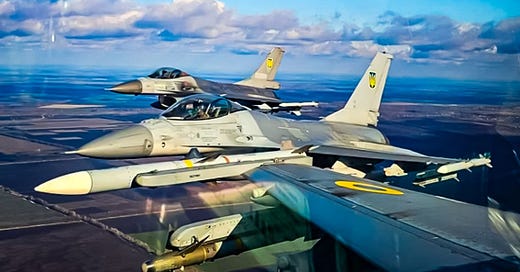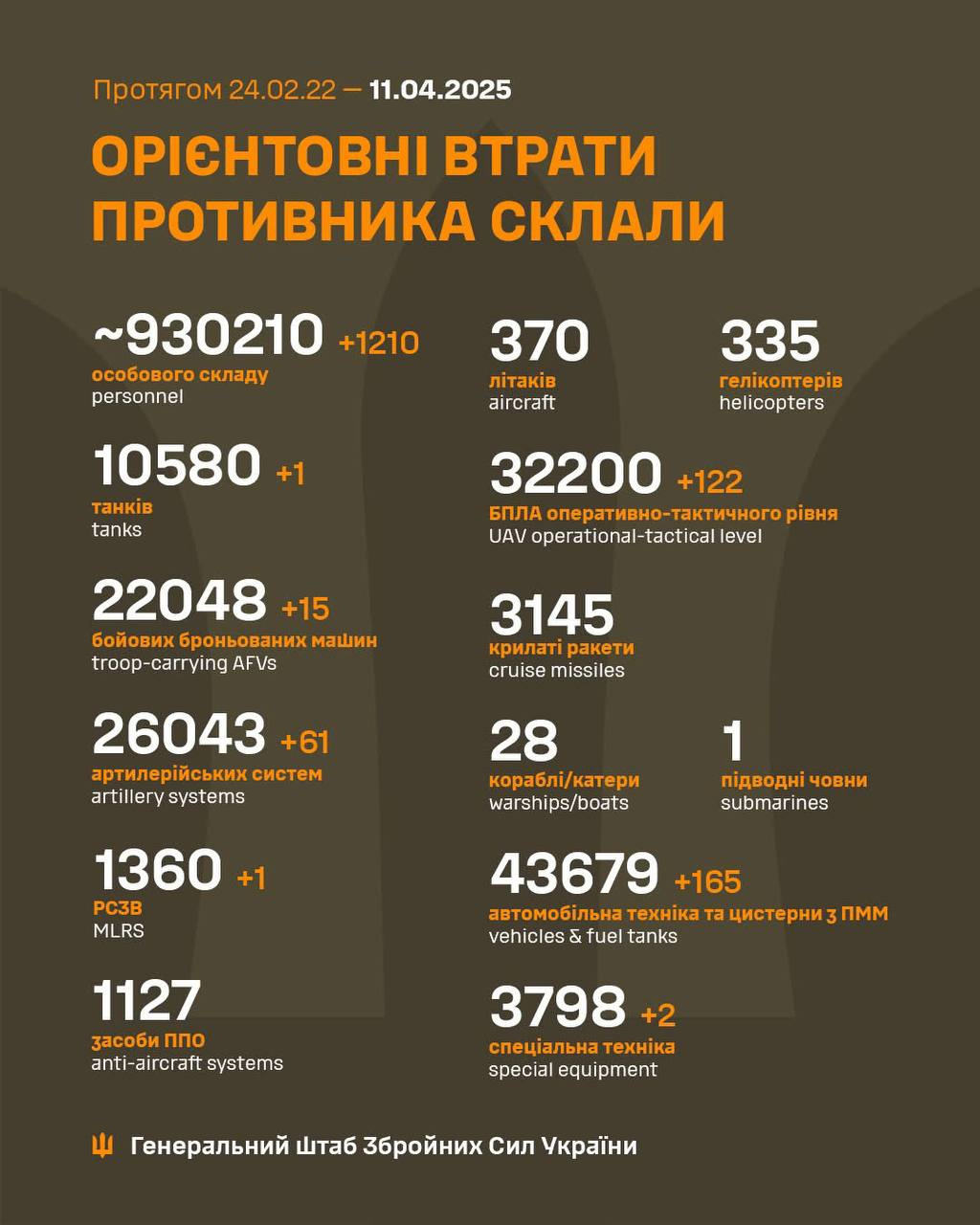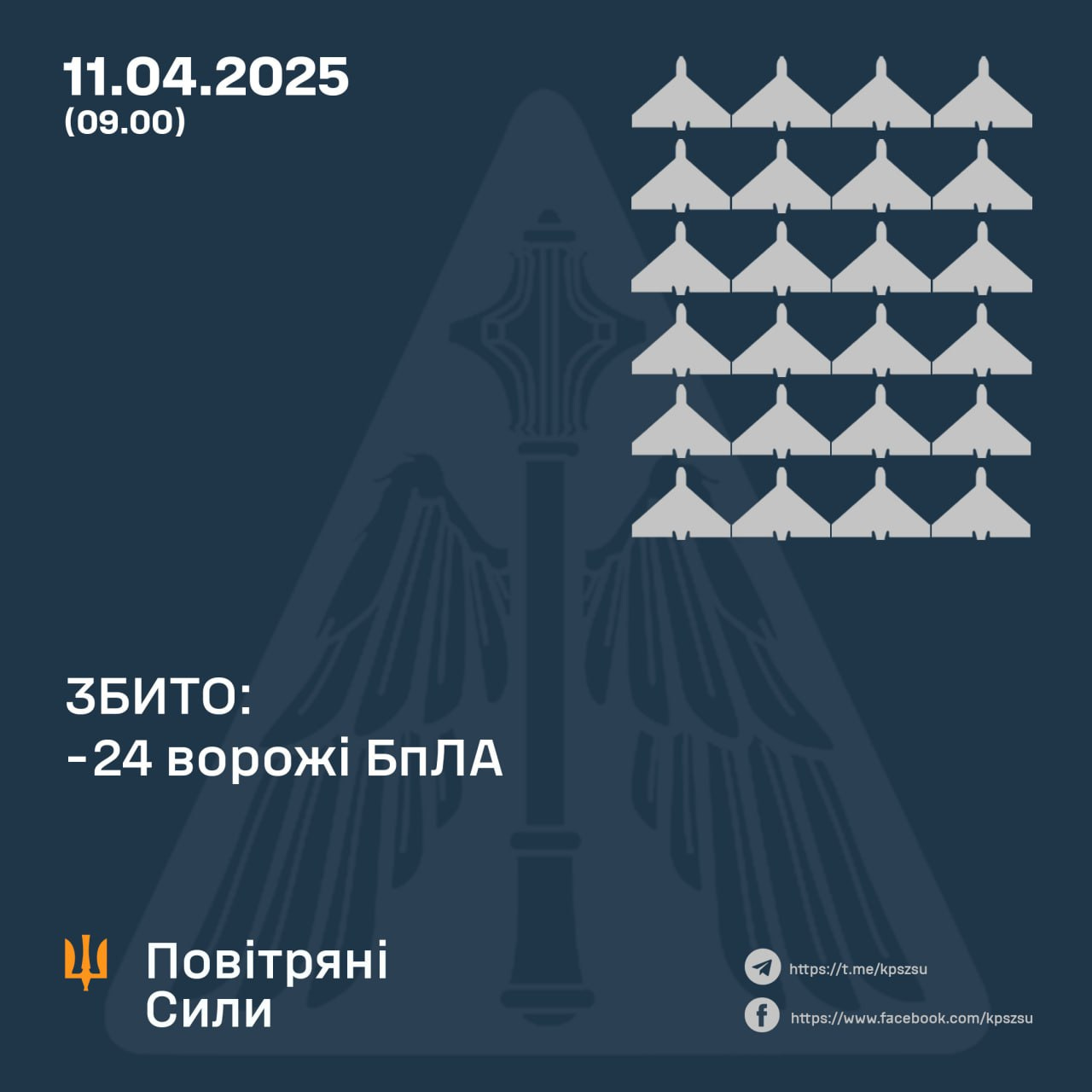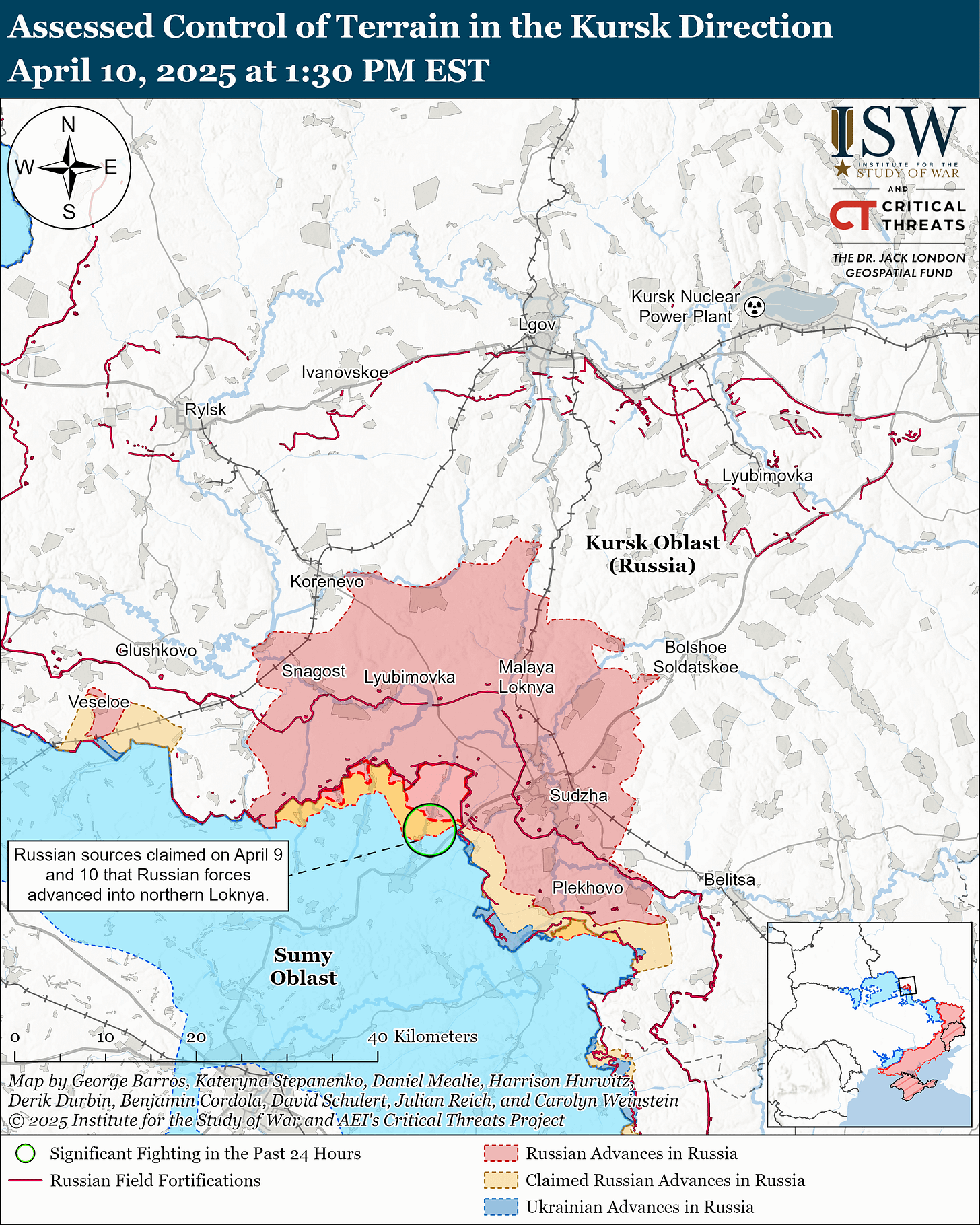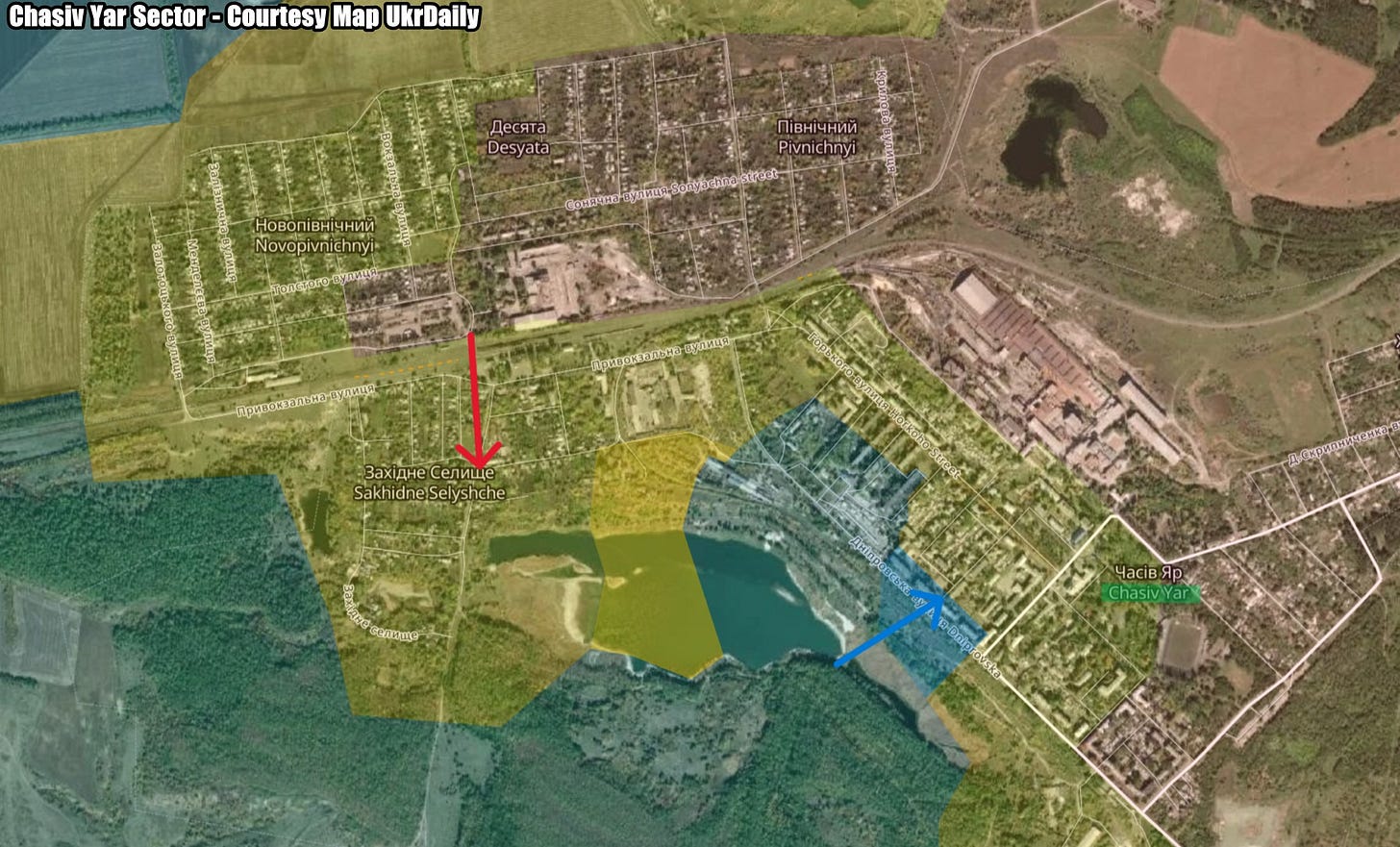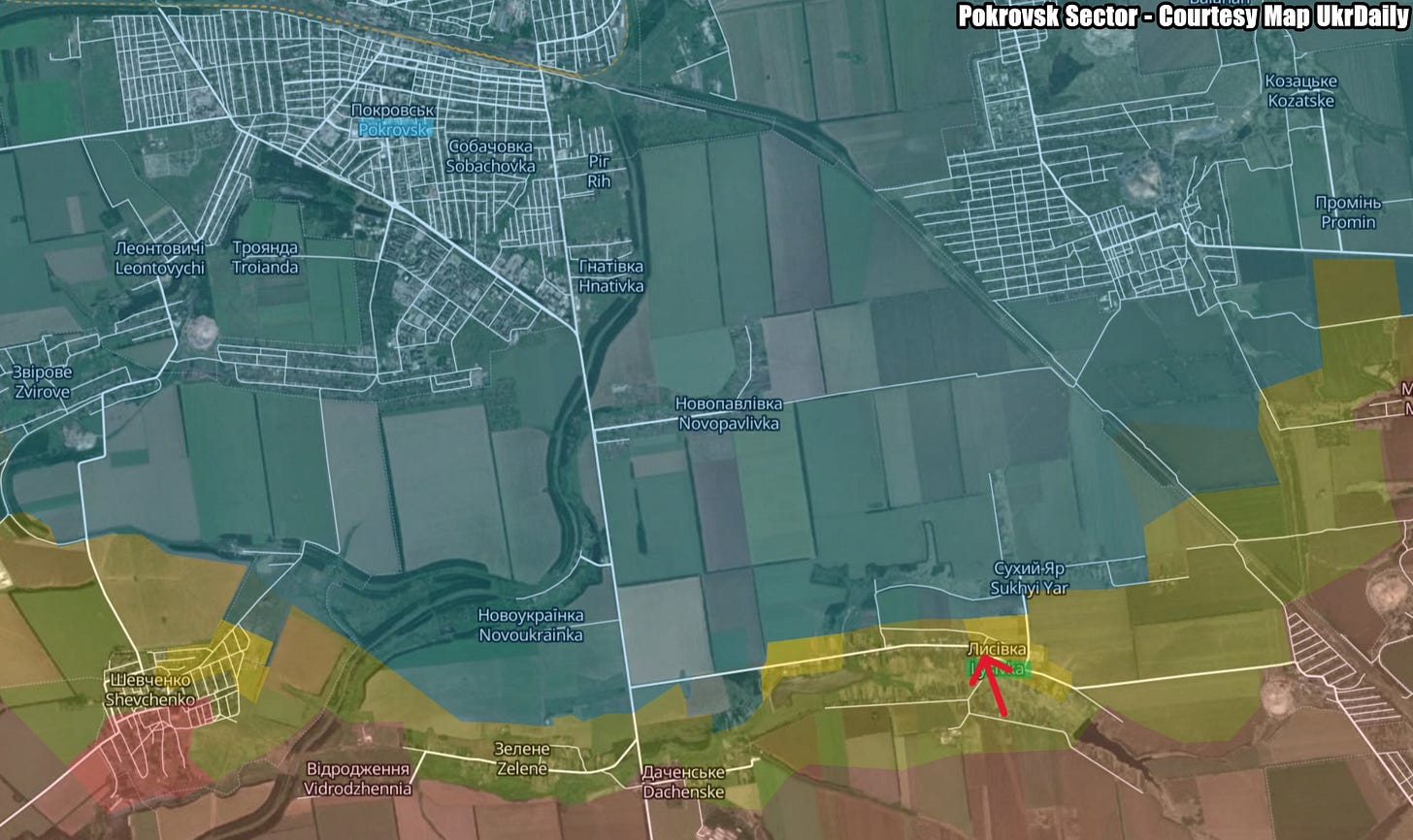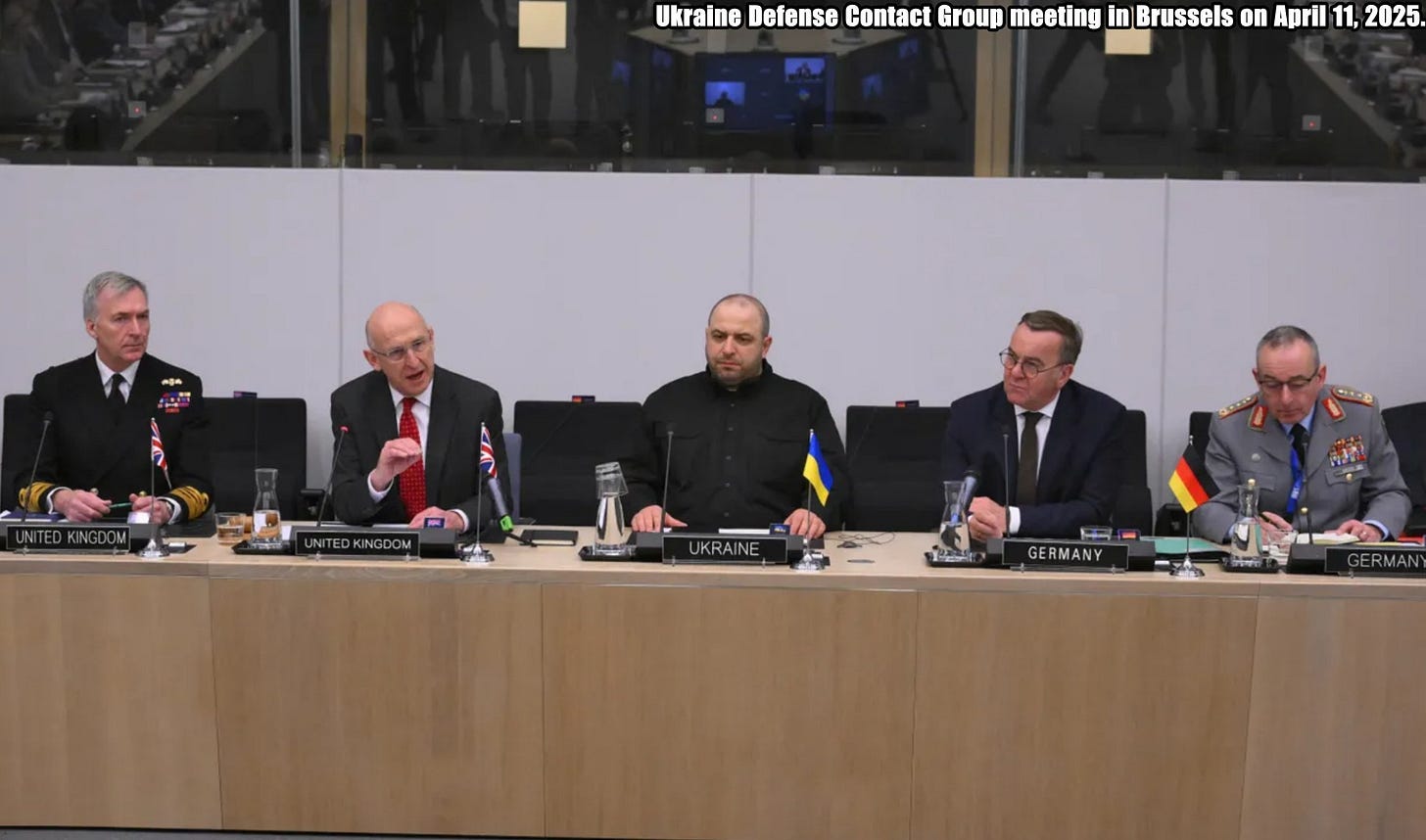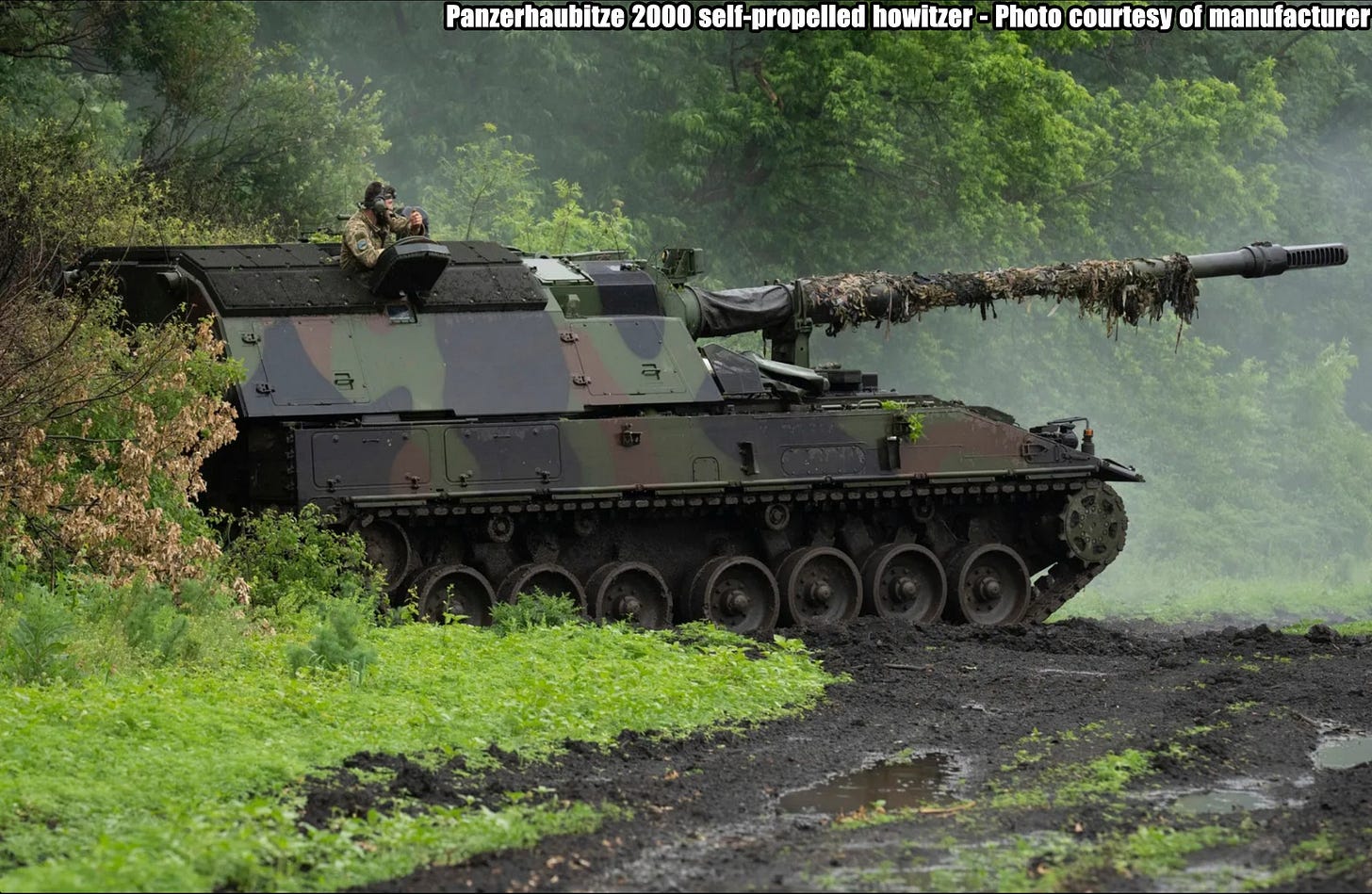Slava Ukraini! In early 2022 I began a Telegram channel aggregating news from a number of sources daily on the war in Ukraine. In June 2023 I began providing a daily draft for the Ukraine War Brief Podcast collecting news from over 70 sources daily, which formed the basis of the script. While the Podcast no longer exists I have continued to make this Brief available for my followers here on Substack for those who wish to keep up with the news from the war.
All the latest news on the Russo-Ukraine War 6 days per week
ALONG THE CONTACT LINE
GSAFU Morning Report
For: Apr 10, 2025
The General Staff of the Armed Forces of Ukraine in its Operational Information update at 08:00 on Apr 10 stated that day 1143 of the full-scale invasion of the Russian Federation against Ukraine had begun.
The situation on the line of combat remains tense in some sectors. Ukrainian defenders continue to actively counteract the Russian aggressor, causing them significant losses in personnel, equipment and technology. Exhausting the enemy along the entire front line and continuing to disrupt the plans of Russian occupiers to advance deeper into the territory of Ukraine.
During the past day,148 combat engagements took place.
Over the past 24 hours, the enemy carried out 2 missile strikes, 106 air strikes, used 2,388 drones and fired approximately 6,000 artillery shells across the positions of Ukrainian forces and civilians.
Air Force Daily Report
24 ENEMY UAVS SHOT DOWN, 13 SIMULATOR UAVS FAILED TO REACH THEIR TARGETS (LOCATIONALLY LOST)
➖➖➖➖➖➖➖➖➖
During the current and past 24 hours (from 09:00 on Apr 10 to 09:00 on Apr 11), the enemy attacked with a ballistic missile (at the city of Dnipro) from the Rostov region and 39 Shahed strike UAVs and simulator drones of various types from the directions: Kursk, Orel, Millerovo, Primorsko-Akhtarsk - Russia.
The air attack was repelled by aviation, anti-aircraft missile troops, electronic warfare units, and mobile fire groups of the Defense Forces of Ukraine.
As of 09:00, it has been confirmed that 24 Shahed attack UAVs (and other types of drones) have been shot down in the north, south, east, and center of the country.
13 enemy drone simulators were lost in location (without negative consequences).
The Dnipropetrovsk, Donetsk, and Zhytomyr regions were affected by the Russian attack.
Combat Operations in the Russian Federation
The Institute for the Study of War (ISW), a US based think tank, in its Apr 10 Russian Offensive Campaign Assessment reported that:
Kursk Sumy Border area: Russian forces continued ground assaults in the Kursk-Sumy Oblast border area on Apr 10 but did not make confirmed advances.
Belgorod Incursion: Ukrainian forces continued limited attacks in Belgorod Oblast on Apr 10.
The Khortytsia operational-strategic group
(Responsible for the northeastern part of Ukraine. )
Chasiv Yar Sector: Ukrainian and Russian forces recently advanced in the Chasiv Yar direction.
Geolocated footage published on April 10 indicates that Ukrainian forces recently marginally advanced along Tsentralna Street in western Chasiv Yar.
Geolocated footage published on Apr 10 indicates that Russian forces recently advanced along Pryvokzalna Street in western Chasiv Yar.
Toretsk Sector: Russian forces recently advanced roughly four kilometers in the Toretsk direction but likely do not maintain enduring positions following the advance.
Geolocated footage published on April 7 indicates that Russian forces recently advanced roughly four kilometers along the T-0516 Toretsk-Kostyantynivka highway to Nelipivka (northeast of Toretsk and south of Kostyantynivka). The footage shows Ukrainian forces striking two Russian vehicles along the road and Russian infantry dismounting to nearby areas. It is unclear if the dismounted infantry consolidated positions in nearby areas or if Russian forces were probing Ukrainian positions. Additional geolocated footage published on Apr 10 indicates that Russian forces recently advanced south of Krymske (northwest of Toretsk), but this change likely did not occur in the past 24 hours.
The Tavria operational-strategic group
(Responsible for the central-eastern and southeastern part of Ukraine.)
Pokrovsk Sector : Russian forces recently advanced in the Pokrovsk direction.
Geolocated footage published on Apr 10 indicates that Russian forces recently advanced in southern and western Lysivka (southeast of Pokrovsk).
The Odesa operational-strategic group
(Responsible for Kherson, Qırım, (also known as Crimea) and the Black Sea.)
There have been no major changes to the combat environment since our last report.
TEMPORARILY OCCUPIED TERRITORIES
Nothing major to report.
THE HOME FRONT
3 killed, 38 injured in Russian attacks on Ukraine over past day.
At least three people were killed and 38 injured in Russian attacks across Ukraine over the past day, regional officials reported on Apr 11. The Kyiv Independent reports.
In Dnipropetrovsk Oblast, one person was killed and 22 injured in drone and missile strikes, Governor Serhii Lysak reported. The attacks targeted civilian areas, igniting fires and causing damage.
The attacks against the region included a missile strike against Dnipro on Apr 10 that killed one civilian and injured nine, officials said.
In Zhytomyr Oblast, a Russian drone struck a residential building in the town of Ozerne, killing one person and injuring six, Governor Vitalii Bunechko said.
Russian attacks killed another person and wounded five in Kherson Oblast, where three apartment buildings and 16 houses were damaged, according to Governor Oleksandr Prokudin. Moscow's forces struck social infrastructure and residential neighborhoods.
In Kharkiv Oblast, four civilians were injured, with houses, garages, and other civilian infrastructure damaged, Governor Oleh Syniehubov said.
One person was also injured in Donetsk Oblast after Russian forces attacked the village of Zarichne, Governor Vadym Filashkin reported.
The attacks came as Russia continues to reject a U.S.-mediated proposal for a full 30-day ceasefire. Kyiv reiterated that it would be ready to accept the truce if Moscow agreed to abide by the terms.
RUSSIAN WORLD
Trump Envoy Meets With RDIF Head Dmitriev in St. Petersburg.
U.S. President Donald Trump’s special envoy Steve Witkoff flew to St. Petersburg on Friday and met with Russian Direct Investment Fund head Kirill Dmitriev, the Moscow times reported citing state media.
The Kremlin confirmed the Trump envoy arrived in Russia and said he would meet with President Vladimir Putin later in the evening. Axios first reported on the meeting earlier on Friday.
Around noon local time, TASS reported that Witkoff held a meeting at the Grand Europe Hotel in St. Petersburg with Dmitriev, who also serves as Putin’s economic envoy. It published a video of the two men leaving the hotel and getting into separate vehicles.
Witkoff hosted Dmitriev in Washington last week, after which the Putin envoy expressed “cautious optimism” about renewed U.S.-Russian diplomatic engagement.
Witkoff’s visit comes a day after the release of U.S.-Russian dual national Ksenia Karelina in a prisoner exchange with the United States in Abu Dhabi. Karelina was swapped with Arthur Petrov, a German-Russian dual national arrested in Cyprus in 2023 at the request of U.S. authorities for allegedly exporting sensitive U.S.-made microelectronics to Russia.
In February, Witkoff was involved in negotiations to release Marc Fogel, an American teacher jailed in Russia on drug charges, in return for Russian cryptocurrency figure Alexander Vinnik. The Trump administration hailed the release of Fogel as a positive step for diplomacy.
Witkoff’s trip to St. Petersburg also comes amid Trump’s growing frustration over stalled efforts to end the war in Ukraine.
Both Ukraine and Russia have accused each other of violating a pause in strikes against energy infrastructure, further dimming hopes for even a partial halt in attacks amid the ongoing war.
The failure of that agreement, which the U.S. brokered, could push Trump to “move forward” with new sanctions on Russia either unilaterally or through Congress if no broad ceasefire is reached by the end of April, Axios cited an anonymous source familiar with the issue as saying.
On Thursday, Trump said “we’re getting relatively close” to achieving a ceasefire.
RELATED INTERNATIONAL NEWS
British troops could be deployed in Ukraine for five years.
Britain is considering deploying troops to Ukraine for five years under plans being discussed by allies, The Telegraph reports.
Military chiefs want the deployment to help train and reconstitute the Ukrainian army to prevent Vladimir Putin from mounting another invasion.
A scheme for a phased withdrawal was raised in the discussions being led by Britain and France over a “coalition of the willing” to uphold any post-conflict peace agreement.
Under the plan, one of a number of options on the table, a European-led force would be dispatched to Ukraine to initially deter Russia from breaching any settlement and to offer Kyiv’s men some much-needed respite.
French military planners have argued that it is highly unlikely Putin would sanction another attack with Western forces inside Ukraine when his troops are only capable of seizing small amounts of territory, The Telegraph understands.
Under the plan, the Franco-British-led “reassurance force” would also offer to help protect Ukraine’s skies and seas.
But the main aim of the deployment would be to immediately start helping to train and rebuild Ukraine’s armed forces to deter another Russian attack. They would later withdraw in stages with final troops to leave around the five year mark, The Telegraph understands.
It would put the UK, France and their Western allies in a race to rebuild and bolster Ukraine’s military before Moscow is once again ready to wage full-scale war.
British, Danish and German intelligence chiefs believe Putin could be ready in as little as five years.
After co-chairing a meeting of 30 nations, John Healey, the Defence Secretary, said he wouldn’t reveal details of the plans being discussed because it “simply makes Putin wiser”.
But he told reporters: “We have discussed, and I confirmed, our four aims or objectives in military planning: secure the skies, secure the seas, support peace on land and support the regeneration and strength of the Ukrainian forces.
Ministers were briefed on recent talks between Admiral Sir Tony Radakin, head of the British Armed Forces, and General Thierry Burkhard, his French counterpart, and their Ukrainian counterparts.
It was then hoped the ministers would discuss what their countries were willing to provide in terms of the potential force, including land, sea and air forces or logistical and intelligence support.
But some officials were disappointed with the response to the plans set out by Adml Sir Tony amid concern the coalition of the willing plans were moving too slowly and remained unclear.
Mr Healey said: “We’re deepening the military planning. It’s not complete, but what today signified was greater momentum.”
Ministers arriving at the talks on Thursday, which were symbolically held at Nato without the Americans, suggested they were still unaware of the format of any potential deployment in Ukraine.
“When it comes to any reassurance force, then also we need to know what it is really about?” asked Kaja Kallas, the EU’s top diplomat.
“Is it deterrence? Is it monitoring? Is it peacekeeping? What is our goal?”
Pal Jonson, Sweden’s defence minister, told reporters: “I think it’s helpful if there’s clarity on what the mission would entail and what we do… if we were a peacekeeping, deterrence or reassurance.”
Discussions over the possible coalition of the willing have become bogged down in recent weeks as the peace talks led by Donald Trump have failed to produce a ceasefire.
This has held up political decisions over the options being drawn up by a team of almost 200 military planners.
Other countries have raised concerns about sending troops to Ukraine without what Sir Keir Starmer has described as a “US backstop”.
So far, Mr Trump has not signalled that he would allow the US to be directly involved in any reassurance force.
But Mr Healey said: “The Americans are taking responsibility for brokering and negotiating the peace, and in most terms, they will have some responsibility and role for securing it for the long term.
“What the coalition of the willing can do is to reinforce that ability to put in place not just a negotiated peace but one that will last.”
The Defence Secretary will return to Nato HQ for further talks over boosting immediate military support for Ukraine on Friday.
In the meeting, co-chaired with Germany, he will announce a £450 million surge in funding for Kyiv, to purchase hundreds of thousands of drones and maintain equipment and vehicles donated by Britain.
“We cannot jeopardise peace by forgetting the war, which is why today’s major package will surge support to Ukraine’s frontline fight,” he will say.
Allies pledge 'record' $23.8 billion to Ukraine at Ramstein summit as UK warns 2025 will be 'critical'
NATO allies committed more than 21 billion euros ($23.8 billion) in long-term military aid to Ukraine during the April 11 meeting of the Ukraine Defense Contact Group (UDCG), British Defense Secretary John Healey said. The Kyiv Independent reported.
"This is record support in military aid to Ukraine," Healey said.
The Ramstein-format meeting in Brussels comes amid growing uncertainty over U.S. support for Ukraine and efforts by European allies to close the gap as Kyiv resists Russia's ongoing invasion.
"2025 is the critical year for this war," Healey said. "Now is the critical moment... for defense industries, militaries and governments to step up."
The defense secretary stressed that the pledges were not only about firepower but about sending a clear message: "We stand with you in the fight and in the peace."
London has allocated 4.5 billion pounds ($5.8 billion) for Ukraine in 2025 — its largest annual contribution to date. The U.K. and Norway earlier pledged an additional 450 million pounds ($585 million) in combined military support.
Germany announced it would send four IRIS-T air defense systems, tanks, armored vehicles, missiles, shells, and more, with the contribution of 11 billion euros (nearly $14.4 billion) through 2029.
The newly unveiled sum shows that "the message was understood very clearly, that the support for Ukraine cannot diminish," Lithuania's Defense Minister Dovile Sakaliene told journalists on the sidelines of the summit, according to a Kyiv Independent reporter.
"Lithuania specifically pledged additionally almost 30 million euros ($34 million), and that means that this year, we have already pledged 110 million euros ($125 million), and we will, of course, reach 200 million ($280 million), and probably go higher," she added.
The pledges come as Russia ramps up attacks on Ukrainian military and civilian targets and rejects ceasefire proposals from U.S. President Donald Trump.
Healey said Russian President Vladimir Putin "continues to drag his feet" and delay negotiations while intensifying strikes on Ukraine.
Launched in 2022 by former U.S. Defense Secretary Lloyd Austin, the UDCG has so far delivered about $126 billion in military aid to Ukraine from roughly 50 countries.
Trump's return to the presidency in January marked a shift in U.S. foreign policy. Washington has not approved new aid for Kyiv in 2025 and has focused instead on pushing for a negotiated settlement with Moscow.
The Feb. 12 Ramstein-format meeting in Brussels was the first not chaired by the U.S. defense secretary, as Pentagon chief Pete Hegseth transferred the role to his British counterpart. Hegseth has not attended the April 11 meeting in person but joined via video link.
Russian 'shadow fleet' tanker detained in Estonia with helicopter support.
Estonia detained the Kiwala oil tanker, which was en route from India’s Sikka port to Russia’s Ust-Luga, according to Commodore Ivo Värk of the Estonian Naval Forces on April 11. New Voice reports.
The investigation into the tanker is not related to any suspected threat to critical infrastructure, officials said. The purpose of the vessel's detention is to verify its documents and legal status.
Veiko Kommusaar, head of the border service at the Police and Border Guard Department, noted that many vessels have entered the Gulf of Finland in the past year without proper documentation. He described these vessels as part of the "shadow fleet."
According to reports, preparations for the operation began on the evening of April 10, and the operation itself started early the next morning.
At 4:19 a.m., the Kiwala tanker, previously sanctioned for illegal activities in the EU and other countries, entered Estonian waters.
Kommusaar stated that the vessel was "without a flag" and "such vessels should not be moving." As a result, Estonia exercised its right to detain the tanker for inspection.
A helicopter was also deployed during the operation to detain the Kiwala.
There are 24 people on board the vessel, and the captain, a Chinese citizen, is cooperating with the investigation.
The Kiwala tanker is reportedly part of Russia's "shadow fleet," which involves vessels constantly changing ownership and management to evade sanctions and conceal the true beneficiaries. This tactic is common in the network of ships involved in Russia's oil trade.
The EU and Switzerland imposed sanctions on the tanker in March 2025 for transporting crude oil and petroleum products originating from Russia.
Oil exports are crucial to supporting the Kremlin’s military operations, and Russia has used its "shadow fleet" — which includes hundreds of tankers that change flags, operate on the high seas, and disable tracking systems — to circumvent international sanctions.
In December 2024, Ukraine's Main Intelligence Directorate identified 238 vessels in the "shadow fleet," which generate billions of dollars in profits for Russia and pose a significant risk to global environmental security.
MILITARY & TECH
Ukrainian troops reportedly face issues with some German weapons.
Ukrainian front-line units are struggling with several German-supplied weapons systems due to technical vulnerabilities, limited spare parts availability, and complicated maintenance, the newspaper Spiegel reported on April 10, citing internal German military documents.
The analysis references a January lecture in Delitzsch by the deputy military attache at the German Embassy in Kyiv, attended by around 200 junior Bundeswehr officers.
According to the transcript, while some German systems have earned praise in Ukraine, others have proven ill-suited for the rigors of high-intensity war.
The Panzerhaubitze 2000 self-propelled howitzer, described as "outstanding" in performance, was said to be so technically sensitive that its "suitability for combat is seriously questionable."
The Leopard 1A5, though labeled "reliable," is reportedly deployed more as improvised artillery due to its inadequate armor. Meanwhile, the more advanced Leopard 2A6 often cannot be repaired on the front due to its costly maintenance and logistical demands.
Ukrainian forces have also faced constraints with air defense systems. The IRIS-T, while effective, suffers from limited availability and high ammunition costs.
The U.S.-made Patriot missile system, another critical component of Ukraine's layered air defense supplied mainly by Germany, has reportedly struggled in the field due to aging MAN carrier vehicles, with spare parts increasingly hard to procure.
The Gepard anti-aircraft systems, however, stood out as the most successful German weapon deployed in Ukraine. Decommissioned before the war and reactivated or sourced from abroad, the system was described in the lecture as "the most popular, effective, and reliable" among Ukrainian troops.
Sources within the Bundeswehr acknowledged that the attache's remarks reflect battlefield realities. German weapons, though often technically advanced, were deployed in Ukraine under extreme conditions that have accelerated wear and tear.
Rapid training provided to Ukrainian troops in Germany often left little time for in-depth technical instruction, compounding logistical challenges.
With repair centers far from the front and Ukraine's infrastructure strained, field maintenance has become a serious obstacle. Despite these challenges, Germany remains Ukraine's top military donor in Europe.
As U.S. President Donald Trump continues to advocate for reduced U.S. involvement in European security and explores restoring relations with Russia, Germany's role is expected to expand further.
Germany's incoming chancellor, Friedrich Merz, has already pledged to rearm the country and boost defense spending, including through a 500 billion euros ($544 billion) infrastructure fund to modernize the Bundeswehr.
Russia’s 70-Year-Old Assault Trucks Got Wiped Out In Eastern Ukraine.
A few weeks after first appearing in significant numbers along the front line in Ukraine, Russian GAZ-69 trucks—museum pieces from the 1950s—seem to have participated in their first direct assault on Ukrainian positions, David Axe of Forbes reports.
“We are an inch away from the GAZ-69 sturm,” open-source intelligence analyst Moklasen predicted on April 1, using slang for “attack.” They were right.
The Thursday assault outside Bilohorivka, at the juncture of Luhansk and Donetsk Oblasts in eastern Ukraine, ended badly for at least one of the 3,500-pound, four-wheel-drive GAZ-69s, which rolled off the assembly line at the Molotov plant in Moscow some time between 1952 and 1972.
The trucks are totally unarmored except for the anti-drone cages some Russian troops weld onto them.
The GAZ-69 was struck by a first-person-view drone from the Ukrainian Abwehr Gruppe drone team, part of the 81st Air Mobile Brigade. The rest of the civilian-style vehicles in the platoon-sized column—potentially including additional GAZ-69s—also came under attack.
“No one arrived, no one reached” Ukrainian positions, the Abwehr Gruppe reported.
The best-protected Russian assault groups struggle to cross the mine-seeded, artillery-pocked, drone-patrolled front line of Russia’s 38-month-long wider war on Ukraine. Lightly protected assault groups in civilian trucks, all-terrain vehicles and motorcycles tend to fare even worse.
But more and more Russian regiments are riding in civilian vehicles as Russia’s losses of purpose-made combat vehicles exceed 20,000 and factories struggle to build new vehicles fast enough.
And that helps to explain why the numerically superior Russian force in eastern Ukraine, which may number more than half a million, has been struggling to gain ground.
“Despite holding the advantage along much of the frontline, Russia’s winter campaign yielded limited results—indicating Ukraine’s situation is not dire,” concluded Tatarigami, the founder of Frontelligence Insight, a Ukrainian analysis group.
That doesn’t mean the better-equipped—or luckier—Russian assault groups won’t advance a short distance here or there. Indeed, Russian regiments gained some ground south of Bilohorivka in recent days, according to the Ukrainian Center for Defense Strategies.
It does mean that, overall, the Russian army in Ukraine is increasingly ill-equipped for a major offensive—and likewise ill-equipped to exploit any localized breakthrough resulting from a successful assault. What was once one of the world’s great mechanized armies is de-mechanizing at a rapid pace.
That’s it for today’s Brief folks if you would like to keep up with events in Ukraine daily please consider subscribing, it’s free!


